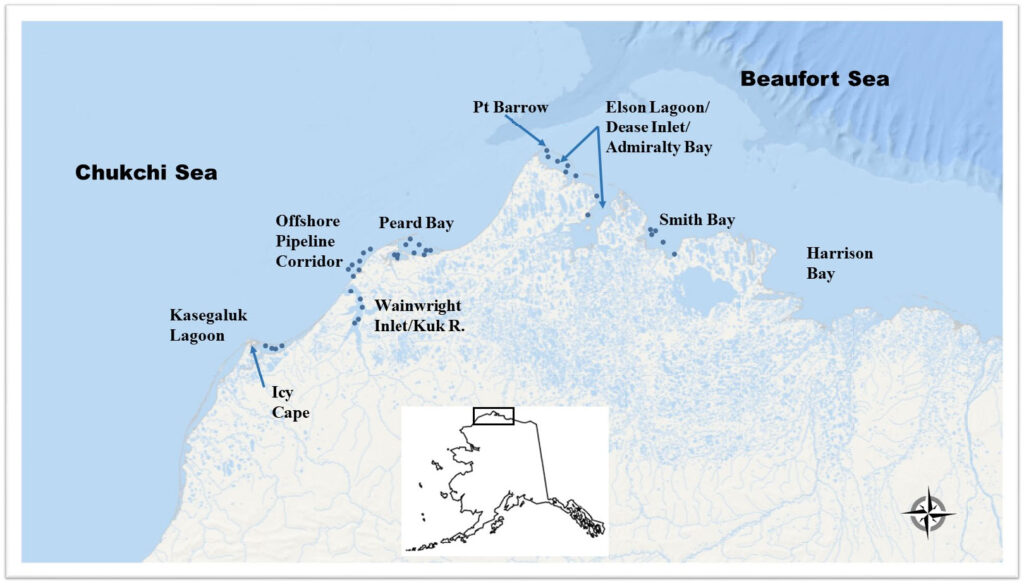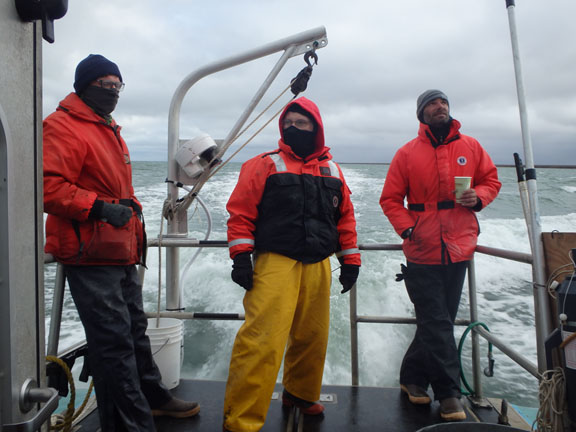We conducted an environmental characterization of lagoons and estuaries in northwest Alaska prior to oil and gas development in the region. Our results will provide natural resource managers and residents in the area baseline information on the state of biological resources and contaminants in Arctic lagoons and estuaries in the path of proposed oil and gas infrastructure.
Why We Care
Many of the contaminant stressor inputs to coastal Alaska ecosystems are driven by long range oceanic currents and atmospheric transport from lower latitudes. However, in the Arctic, current and future oil and gas extraction and transport on the water and in the watershed constitute the most significant pollution threats to the water and habitat quality in the region.
Despite considerable test drilling in the area, environmental studies in the area are few, resulting in a lack of adequate baseline data and information to assess future trends for estuaries in the National Petroleum Reserve in Alaska. We collected sediment chemistry data, benthic community information, fish tissue contaminant data, and information about ecological connections to determine the current state of these estuaries.
What We Did
We collected samples from the near-shore and estuarine waters of five estuaries in the northern Chukchi Sea and western Beaufort Sea. The study area includes the Kasegaluk Lagoon, Wainwright Inlet, Peard Bay, Elson/Dease/Admiralty Bay, and Smith Bay. Additionally, we sampled two transects offshore from Wainwright Inlet near a potential oil pipeline corridor identified by the oil industry.
At each location, we collected water quality data (dissolved oxygen, salinity, turbidity, and temperature), and multiple sets of surficial sediment samples to assess sediment contaminant concentrations, determine sediment grain size, characterize sediment benthic communities, and conduct stable isotope analyses. In keeping with the methods of the NCCOS National Status and Trends – Bioeffects Program, we used a stratified random design for bottom habitat characterization.
Also, we attempted to collect resident fish from each estuary. We analyzed these fish samples for contaminant body burdens.
Our laboratory analyses included:
- Quantification of over 194 organic and inorganic contaminants in the sediment and tissue samples.
- Sediment benthic community characterizations involving enumeration of density, species richness, and diversity. In addition, we conducted pattern analysis and classification to delineate taxa assemblages.
- Stable isotope analysis of nitrogen and carbon to explore exchanges between environmental compartments.
We collaborated with the Alaska Department of Environmental Conservation and the University of Alaska Fairbanks to conduct this study.

What We Found
Our preliminary findings thus far indicate that:
- The estuaries are relatively shallow embayments, with little relief along the shorelines. Sediment characteristics varied widely depending on location, but were either sand or silt. The water columns were turbid, high salinity, and were not stratified. The estuaries along the Beaufort Sea were colder than estuaries along the Chukchi Sea.
- Concentrations of arsenic and nickel were elevated throughout the region and appear to be naturally elevated in the watersheds. Concentrations of lead and mercury were uniformly low.
- Concentrations of PAHs were relatively high for pristine locations, but did not appear to include petroleum hydrocarbons. Characteristics of the PAH compounds present indicate large contributions of terrestrial organic matter and peat and/or coal.
- Concentrations of chlorinated pesticides and PCBs were uniformly low, but detectable in fish tissue. PCB and cyclodiene (e.g., chlordane) concentrations were, on average, half of those seen in Nushagak and Kvichak Bays in southeast Bristol Bay. Hexachlorobenzene was detected in all fish samples.
- With the exception of Peard Bay, the sampled estuaries were shallow and subject to landfast ice throughout the winter season. This places a high stress on the benthos. Older organisms were rare, suggesting that these macroinvertebrates are recruited as larvae or juveniles into the estuaries after ice breakup.
- Benthic samples were sieved through nested 1.0 and 0.5 mm sieves to compare techniques. The information gained by looking at 0.5 mm improves estimates of diversity and abundance.
- With the exception of Peard Bay, all the estuaries reflected the strong influence of terrestrial plant input with very low δo/oo values for carbon and nitrogen. Peard Bay has a very limited watershed and is strongly influenced by tidal exchange with marine waters. Stable isotope values for Peard Bay were bracketed by the offshore sites.
Project partners included NOAA’s Office of Response & Restoration, the University of Alaska Fairbanks, and the Alaska Department of Environmental Conservation.

